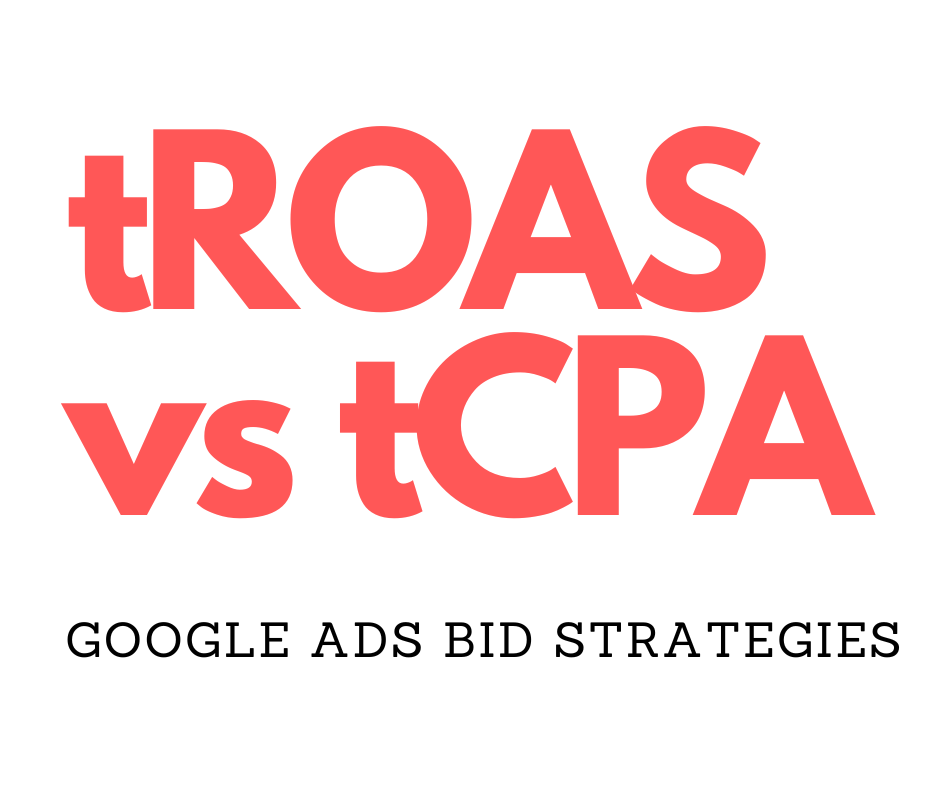
tROAS vs tCPA: Mastering the Google Ads Bidding Battlefield
The choice between tROAS vs tCPA in Google Ads can feel like navigating a labyrinth blindfolded. Both are automated bidding strategies, but they champion different goals: tROAS fights for maximum return on ad spend (ROAS), while tCPA prioritizes acquiring conversions at a specific cost.
Need help with your Google Ads? Contact us here
Your Google Ad Campaign Bid Strategy Types
- tROAS: This option thrives on maximizing the revenue generated from every ad dollar spent. Aiming for a specific ROAS percentage, it delivers punches of high profitability. However, it relinquishes some control over individual bids.
- tCPA: This option prioritizes efficiency in acquiring customers. With a laser focus on a specific cost per conversion (CPA), it ensures predictable customer acquisition costs, but doesn’t directly guarantee a specific ROAS.
Picking Your Champion:
Before selecting your bidding hero, contemplate these crucial questions:
- Your Ultimate Goal: Are you seeking high ROAS or predictable customer acquisition costs?
- Data Arsenal: Do you have a well-stocked arsenal of historical conversion data and a clear understanding of your average order value (AOV)? This is crucial for tROAS.
- Target CPA in Sight: Do you have specific CPA targets locked and loaded? tCPA is your sharpshooter.
- Bidding Control: Are you comfortable handing over some bid control for potentially higher ROI? Consider tROAS, but be prepared to adapt.
Campaign Setup for Victory:
- Realistic Goals: Set achievable ROAS targets in tROAS and reasonable CPA limits in tCPA. Don’t be too ambitious initially, refine as data accumulates.
- Conversion Tracking: Ensure your conversion tracking is accurate and battle-ready, especially for tROAS, as it relies heavily on this data.
- Campaign Budget: Allocate sufficient budget for both strategies. Remember, tCPA might spend more aggressively to reach your target CPA.
Winning Strategies in Action:
- eCommerce: tROAS shines here, maximizing revenue from ad spend and leaving competitors in the dust.
- Lead Generation: tCPA is ideal for acquiring leads at a predictable cost, ensuring you don’t overspend on each recruit.
- Brand Awareness: Start with Maximize Clicks to gain initial ground, then use tROAS for retargeting campaigns to convert those engaged users.
Remember: The optimal strategy depends on your specific business goals and data. Experiment, analyze, and adapt to find your bidding champion!
Also check out our keyword match type guide here

Setting Up for Success: Mastering tROAS and tCPA in Google Ads
Now that you’ve chosen your bidding champion (tROAS or tCPA) in the Google Ads arena, it’s time to equip them for battle. This guide details the campaign setup process for each strategy, including best practices for quick results and website optimization to maximize their effectiveness.
tROAS: Optimizing for Maximum Return
Campaign Creation:
- Campaign Type: Choose a campaign type aligned with your ROAS goals, such as Shopping or Search Network with Shopping ads.
- Bidding Strategy: Select “Target ROAS” and set a realistic initial target based on historical data or industry benchmarks. Start slightly conservative and refine as performance data accumulates.
- Budget: Allocate a sufficient budget to allow the algorithm to explore and optimize effectively. Consider historical spend and campaign goals.
- Targeting: Refine your targeting based on audience demographics, interests, and behaviors relevant to your high-value customers.
- Ad Groups & Ads: Create well-organized ad groups with relevant keywords and ad copy that resonates with your target audience and highlights product value.
Best Practices for Quick Results:
- Conversion Tracking: Ensure accurate conversion tracking is set up, including relevant conversion values for accurate ROAS calculation.
- Product Feed Quality: Optimize your product feed with high-quality images, clear descriptions, and accurate pricing to improve ad performance.
- Landing Page Optimization: Ensure landing pages offer a seamless user experience, are relevant to the ad, and clearly guide users towards conversion.
- Remarketing: Implement remarketing campaigns to target users who have already interacted with your brand, potentially with a higher ROAS target.
Website Optimization for tROAS:
- Clear Value Proposition: Communicate your product’s or service’s value proposition prominently on your website to justify your target ROAS.
- Optimize for Conversions: Streamline the path to conversion with clear calls to action, user-friendly navigation, and a smooth checkout process.
- Personalization: Implement personalization strategies to cater to individual user needs and increase conversion rates.
- Mobile-Friendliness: Ensure your website is mobile-optimized for seamless conversion across devices.
tCPA: Prioritizing Predictable Acquisition Costs
Campaign Creation:
- Campaign Type: Choose a campaign type aligned with your acquisition cost goals, such as Search Network or App campaigns.
- Bidding Strategy: Select “Target CPA” and set a realistic initial target based on historical data, campaign goals, and customer lifetime value.
- Budget: Allocate a sufficient budget to allow the algorithm to acquire enough conversions for accurate optimization.
- Targeting: Refine your targeting based on demographics, interests, and behaviors relevant to your ideal customers.
- Ad Groups & Ads: Create well-organized ad groups with relevant keywords and ad copy that compels users to convert.
Best Practices for Quick Results:
- Conversion Tracking: Ensure accurate conversion tracking is set up to provide the algorithm with clear conversion signals.
- Landing Page Optimization: Optimize landing pages specifically for the targeted keywords and ad copy to improve conversion rates.
- A/B Testing: Test different ad variations and landing pages to identify the most effective combinations for reaching your target CPA.
- Audience Exclusion: Exclude irrelevant audiences who are unlikely to convert and potentially inflate your CPA.
Website Optimization for tCPA:
- Lead Capture Forms: Optimize lead capture forms to be concise and user-friendly to reduce abandonment rates.
- Live Chat Support: Offer live chat support to address user concerns and potentially increase conversion rates.
- Social Proof: Showcase testimonials, reviews, and case studies to build trust and encourage conversions.
- Clear Value Proposition: Clearly communicate the benefits of your offering to justify your target CPA.
Remember, both tROAS and tCPA are powerful tools, but their effectiveness depends on your specific goals, data, and website optimization efforts. Experiment, analyze, and adapt your approach to find the winning strategy for your unique business needs!

Leave a Reply